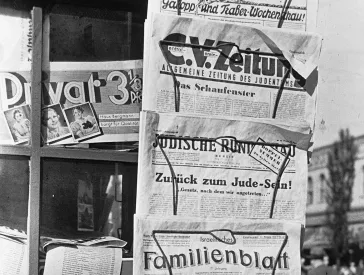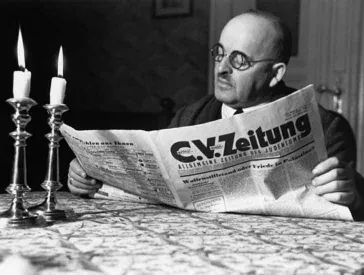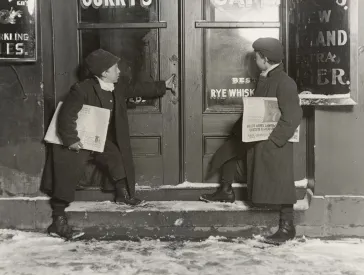Opening of the Exhibition
Claude Lanzmann: The Recordings
Press Release, Thu 27 Nov 2025
To mark the 100th birthday of Claude Lanzmann (1925–2018) – the renowned French journalist, filmmaker, and chronicler of the Shoah – the Jewish Museum Berlin (JMB) is presenting an exhibition that brings history to life through sound: Claude Lanzmann: The Recordings. “We are proud to make the audio archive of original recordings for Lanzmann’s world-famous documentary Shoah (1985) available to the public for the first time,” says Hetty Berg, director of the JMB.
- Contact
-
Dr. Margret Karsch
Head of Press
T +49 (0)30 259 93 419
presse@jmberlin.deMelanie Franke
Press Officer
T +49 (0)30 25 993 340
presse@jmberlin.de
- Address
Jewish Museum Berlin Foundation
Lindenstraße 9–14
10969 Berlin
The recordings document the numerous conversations with survivors, perpetrators, and third parties that Lanzmann and his colleagues Corinna Coulmas and Irena Steinfeldt-Levy conducted in the 1970s during their many years of research prior to filming. Shoah shaped international perceptions of the genocide of European Jews. The film runs nine hours and 26 minutes and contains no archival footage.
“In late 2021, the Association Claude et Felix Lanzmann (A.C.F.L.), represented by Dominique Lanzmann, donated Claude Lanzmann’s audio archive to the JMB,” explains Hetty Berg. “It now forms the heart of our Lanzmann Collection, which we have been cataloging ever since. Together with Shoah, the Lanzmann Collection was added to the UNESCO Memory of the World Register in 2023.” Including the additional cassettes received in 2022, the archive now comprises more than 220 hours of audio. The JMB has digitized all 152 audio cassettes and transcribed their content. Once the exhibition opens, an initial set of recordings will be published in a publicly accessible online edition with German and English translations, with the gradual publication process to be completed by the end of 2027. In the interviews presented at the exhibition, the participants speak French, German, English, Hebrew, Yiddish, and Polish.
Curator Dr. Tamar Lewinsky explains: “The exhibition takes visitors on a unique auditory journey. Selected original recordings trace Lanzmann’s research and offer insight into the multilayered memories of the Shoah in the 1970s.” A restrained visual design encourages close listening. The exhibition features roughly 90 minutes of audio.
Wearing headphones, visitors can move freely through the space, pause in one of the listening areas, and explore the exhibition’s six thematic focuses at their own pace. In the first section, visitors hear Lanzmann speaking with others about the project, describing what it meant for him financially and psychologically and the methodological challenges it posed. The second section introduces interviewees who later withdrew from the project and were therefore never filmed. The third section focuses on perpetrators, showing how Lanzmann managed to coax them into speaking and how they reflected on – or failed to reflect on – their actions. The fourth section examines the Holocaust in Lithuania as representative of the many research topics that did not make it into the film. The fifth presents Lanzmann’s 1978 trip to Poland, including his first visit to the Auschwitz-Birkenau memorial site and other locations, as well as his conversations with eyewitnesses. The sixth section juxtaposes selected audio and film recordings from the raw material.
Monitors provide transcripts and translations of the various languages in which the conversations were held. The recordings include background sounds from the different settings – the clatter of dishes, children’s voices, footsteps – creating a distinct atmosphere that prompts visitors to reflect on the possible meaning of every sound. The recordings are further contextualized by original documents from Claude Lanzmann’s private archive, by a video interview conducted by the JMB with his colleagues in 2025, and by additional documents and film footage.
“It is of great importance to me to support this significant project. Considering the shameful rise in antisemitism and that we are losing the last of those who can bear witness, we are all called upon to strengthen the memory of the Shoah and to create spaces where history can be experienced and reflected upon. By promoting the educational work on Claude Lanzmann’s audio archive, we at the Federal Foreign Office want to contribute to the preservation and further development of our culture of remembrance,” says Foreign Minister Dr Johann Wadephul.
Lena Altman, co-CEO of the Alfred Landecker Foundation, notes: “The Lanzmann Audio Archive preserves uniquely powerful testimonies of the twentieth century – voices of Holocaust survivors as well as those of perpetrators. It demonstrates the profound work that remembrance can accomplish when it makes the horror tangible through the voices of those who endured it, witnessed it, or indeed caused it. At a time when the last eyewitnesses are falling silent and antisemitism is once again on the rise, the archive ensures access to these voices and keeps their stories alive in the consciousness of generations to come.”
“Claude Lanzmann was one of the first French intellectuals to support a postwar rapprochement between our two countries, understanding that art, culture, and knowledge had never been the property of the Nazis and that European unification had to be imagined and built immediately after the war, free of resentment and any desire for revenge” says François Delattre, French Ambassador to Germany.
The exhibition will be on view at the New York Historical from 28 November 2025 to 29 March 2026 and at the Mémorial de la Shoah in Paris from 10 December 2025 to 29 March 2026.
Current information about the project is available at: https://www.jmberlin.de/en/exhibition-claude-lanzmann-recordings
Effective today, all of the recordings featured in the exhibition can be explored – together with supplementary material – on the online platform Oral-History.Digital (OH.D). The complete set of recordings in the Lanzmann Collection will be made accessible there by the end of 2027: https://www.oral-history.digital/en/index.html.
Duration: 28 November 2025 to 12 April 2026
Location: Jewish Museum Berlin, Eric F. Ross Gallery
Admission: Free
Opening hours: Daily, from 10 am to 6 pm
The accompanying program includes, among other events, an academic conference in 2026 and workshops for school groups. On the learning platform JMB di.kla – Jewish Content for Your Class available in English and German, visitors will find a digital learning module featuring an animated film about Lanzmann and his preparations for Shoah. It explores questions of memory and eyewitness testimony. Please visit https://dikla.jmberlin.de/en/.
Supported by the German Foreign Office and the Alfred Landecker Foundation.




